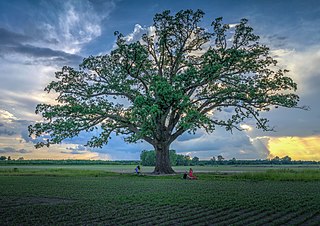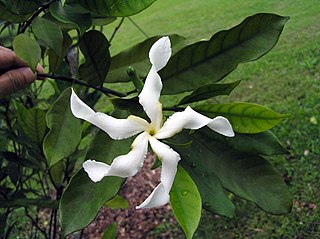Cypress is a common name for various coniferous trees or shrubs of northern temperate regions that belong to the family Cupressaceae. The word cypress is derived from Old French cipres, which was imported from Latin cypressus, the latinisation of the Greek κυπάρισσος (kyparissos). Cypress trees are a large classification of conifers, encompassing the trees and shrubs from the cypress family (Cupressaceae) and many others with the word “cypress” in their common name. Many cypress trees have needle-like, evergreen foliage and acorn-like seed cones.

Hesperocyparis macrocarpa is a coniferous tree. It is commonly known as the Monterey cypress and is one of several species of cypress trees endemic to California.

Quercus macrocarpa, the bur oak or burr oak, is a species of oak tree native to eastern North America. It is in the white oak section, Quercus sect. Quercus, and is also called mossycup oak, mossycup white oak, blue oak, or scrub oak. The acorns are the largest of any North American oak, and are important food for wildlife.

Carissa macrocarpa is a shrub native to tropical and southern Africa. It is commonly known as the Natal plum and, in South Africa, the large num-num. In Zulu, as well as in the Bantu tribes of Uganda, it is called Amathungulu or umThungulu oBomvu. In Afrikaans the fruit is called noem-noem.
Pterygota macrocarpa is a species of flowering plant in the family Malvaceae. It is found in Cameroon, Ivory Coast, Ghana, Nigeria, and Sierra Leone. It is threatened by habitat loss.
Clinosperma macrocarpa is a species of palm tree known from a single population at around 500 metres (1,600 ft) altitude on Mont Panié, New Caledonia. It was described as the only species in the genus Lavoixia, but has since been moved to genus Clinosperma. It is listed as critically endangered on the IUCN Red List.
Syagrus macrocarpa is a rare species of palm found only as scattered isolated individuals and small groups in the east of the Brazilian states of Espírito Santo, Minas Gerais and Rio de Janeiro. It grows to 4-10m tall, with 8-20 leaves to 2m long. The leaves are bent at the end, with very hairy margins near the trunk, and consist of 180-320 slightly coiled leaflets irregularly arranged in several planes on the rake. The fruit are oval, greenish-yellow, 6–9 cm long. It is grown in cultivation. Seeds are difficult to germinate, with low rates of germination. Common names for it in Minas Gerais are baba-de-boi-grande and maria-rosa.
Aglaia macrocarpa is a species of plant in the family Meliaceae. It is found in Brunei, Indonesia, Malaysia, Singapore, Thailand, Vietnam, and possibly the Philippines.
Agonandra macrocarpa is a species of plant in the family Opiliaceae. It is found in Costa Rica and Honduras. It is threatened by habitat loss.
Casearia macrocarpa is a species of flowering plant in the family Salicaceae. It is a tree endemic to Peninsular Malaysia. It is threatened by habitat loss.
Euodia macrocarpa is a species of plant in the family Rutaceae. It is a tree endemic to Peninsular Malaysia. It is threatened by habitat loss.

Hieronyma macrocarpa is a species of plant in the family Phyllanthaceae, which was recently separated from the Euphorbiaceae. It is found in Colombia and Ecuador.
Chalybea macrocarpa is a species of plant in the family Melastomataceae. It is endemic to Boyacá Department in Colombia.
Mangifera macrocarpa is a species of plant in the family Anacardiaceae. It is a tree found in Indonesia, Malaysia, Singapore, and Thailand.
Mastixia macrocarpa is a tree in the family Nyssaceae. The specific epithet macrocarpa is from the Greek meaning "large fruit".
Pouteria macrocarpa is a species of plant in the family Sapotaceae. It is found in Brazil, Colombia, and Costa Rica.
Psychotria macrocarpa is a species of plant in the family Rubiaceae. It is native to Kerala and Tamil Nadu in India.
Vateria macrocarpa is a species of plant in the family Dipterocarpaceae. It is endemic to India.

Tabernaemontana macrocarpa grows as a shrub or tree up to 30 metres (100 ft) tall, with a trunk diameter of up to 50 centimetres (20 in). The bark is yellowish brown, brown, grey-brown or grey. Its fragrant flowers feature combinations of cream, white and orange corolla lobes. The fruit is orange, with paired follicles, each up to 16 centimetres (6 in) in diameter. The specific epithet macrocarpa is from the Greek meaning "with large fruit". Its habitat is forests from sea level to 1,500 metres (5,000 ft) altitude. Tabernaemontana macrocarpa has been used as arrow poison. The species is native to Thailand and Malesia.
Pteralyxia laurifolia, the ridged pteralyxia, is a species of plant in the family Apocynaceae. It is endemic to the Island of Oahu in the Hawaiian Islands. The species is listed as vulnerable, threatened by habitat loss.





